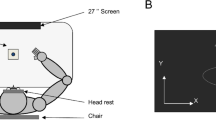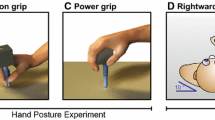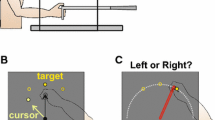Abstract
Previous findings from our laboratory support the idea that the dominant arm is more proficient than the non-dominant arm in coordinating intersegmental dynamics for specifying trajectory direction and shape during multijoint reaching movements. We also showed that adaptation of right and left arms to novel visuomotor rotations was equivalent, suggesting that this process occurs upstream to processes that distinguish dominant and non-dominant arm performance. Because of this, we speculate that such visuomotor adaptations might transfer to subsequent performance during adaptation with the other arm. We now examine whether opposite arm training to novel visuomotor rotations transfers to affect adaptation using the right and left arms. Two subject groups, RL and LR, each comprising seven right-handed subjects, adapted to a 30° counterclockwise rotation in the visual display during a center-out reaching task performed in eight directions. Each group first adapted using either the right (RL) or left (LR) arm, followed by opposite arm adaptation. In order to assess transfer, we compared the same side arm movements (either right or left) following opposite arm adaptation to those performed prior to opposite arm adaptation. Our findings indicate unambiguous transfer of learning across the arms. Different features of movement transferred in different directions: Opposite arm training improved the initial direction of right arm movements under the rotated visual condition, whereas opposite arm training improved the final position accuracy, but not the direction of left arm movements. These findings confirm that transfer of training was not due to a general cognitive strategy, since such an effect should influence either hand equally. These findings support the hypothesis that each arm controller has access to information learned during opposite arm training. We suggest that each controller uses this information differently, depending on its proficiency for specifying particular features of movement. We discuss evidence that these two aspects of control are differentially mediated by the right and left cerebral hemispheres.
Similar content being viewed by others
Author information
Authors and Affiliations
Corresponding author
Rights and permissions
About this article
Cite this article
Sainburg, R.L., Wang, J. Interlimb transfer of visuomotor rotations: independence of direction and final position information. Exp Brain Res 145, 437–447 (2002). https://doi.org/10.1007/s00221-002-1140-7
Received:
Accepted:
Published:
Issue Date:
DOI: https://doi.org/10.1007/s00221-002-1140-7




